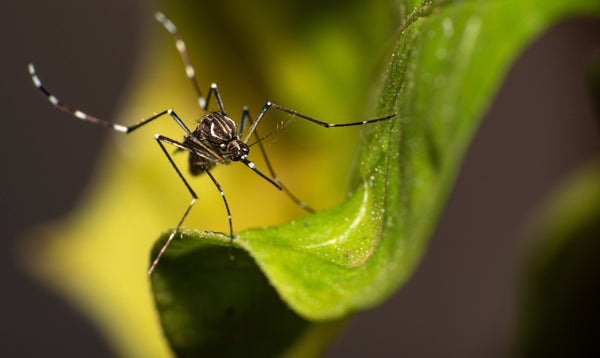CLIMATEWIRE | Scientists have warned that some mosquito-borne diseases, like malaria and dengue fever, may spread into new territories as the world warms. So they started breeding special mosquitoes that could slow the transmission of viruses.
But until now, researchers weren’t sure if climate change would kill off these disease-resistant insects before they could make a difference.
A new study, published Thursday in the journal Nature Climate Change, suggests that the disease-quashing bugs will likely survive for at least the next couple of decades. Their fate is less certain further into the future.
On supporting science journalism
If you're enjoying this article, consider supporting our award-winning journalism by subscribing. By purchasing a subscription you are helping to ensure the future of impactful stories about the discoveries and ideas shaping our world today.
The study focuses on a special insect-borne bacterium called Wolbachia, which has natural virus-blocking properties and is carried in different insect populations, including some mosquito species.
It’s not typically found in Aedes aegypti, or the “yellow fever mosquito,” one of the most significant disease-carrying species on the planet. But scientists have figured out ways to introduce the bacteria into Aedes aegypti populations — and potentially slow the transmission of diseases including yellow fever and dengue fever and the Zika and chikungunya viruses.
Researchers have already launched several trial programs around the world, including in Queensland in Australia, Rio de Janeiro in Brazil and parts of Vietnam.
But Wolbachia has a weakness. The strain scientists usually use in Aedes aegypti mosquitoes is sensitive to heat. When daily average temperatures reach about 95 degrees, it tends to start disappearing from the population.
The new study is among the first to investigate whether rising temperatures might pose a risk for Wolbachia-carrying mosquitoes in the coming decades.
The research focuses on Cairns, Australia, one of the places disease-resistant mosquitoes have already been introduced. It uses a special model that mimics mosquito population dynamics to simulate how the bugs might respond as the region warms.
Assuming moderate to severe levels of future climate change, the study finds that the Wolbachia-carrying population is likely to survive at least through the 2030s — even as heat waves worsen.
By the 2050s, the population is likely to decline during the hotter summer months. But warmer winters are actually conducive to mosquito breeding, and the population could rebound during the cooler parts of the year.
That’s just in Australia.
The researchers found that the mosquito might not fare as well in other parts of the world. They conducted a similar analysis for Nha Trang, Vietnam, another place where the disease-resistant mosquitoes have already been released. The modeling found that Wolbachia-mosquito numbers are likely to plummet in the 2050s, thanks to longer and more intense heat waves.
Overall, the research suggests that Wolbachia-carrying mosquitoes may be more vulnerable in some parts of the world than in others. And while populations might be relatively resilient through the 2030s, they’re likely to face growing heat-related challenges in later, hotter decades.
Still, Wolbachia isn’t the only disease-fighting method in the toolbox.
Scientists have also developed genetically modified mosquitoes, carrying a gene that causes future generations to gradually die off. While Wolbachia prevents mosquitoes from transmitting viruses without actually killing them, the GMO strategy aims to directly reduce mosquito populations.
Biotechnology firm Oxitec launched a GMO mosquito trial in the Florida Keys in 2021. Last year, it announced that the test seemed to be working — but more research is needed to determine whether it’s an effective strategy in the long term.
Reprinted from E&E News with permission from POLITICO, LLC. Copyright 2023. E&E News provides essential news for energy and environment professionals.
